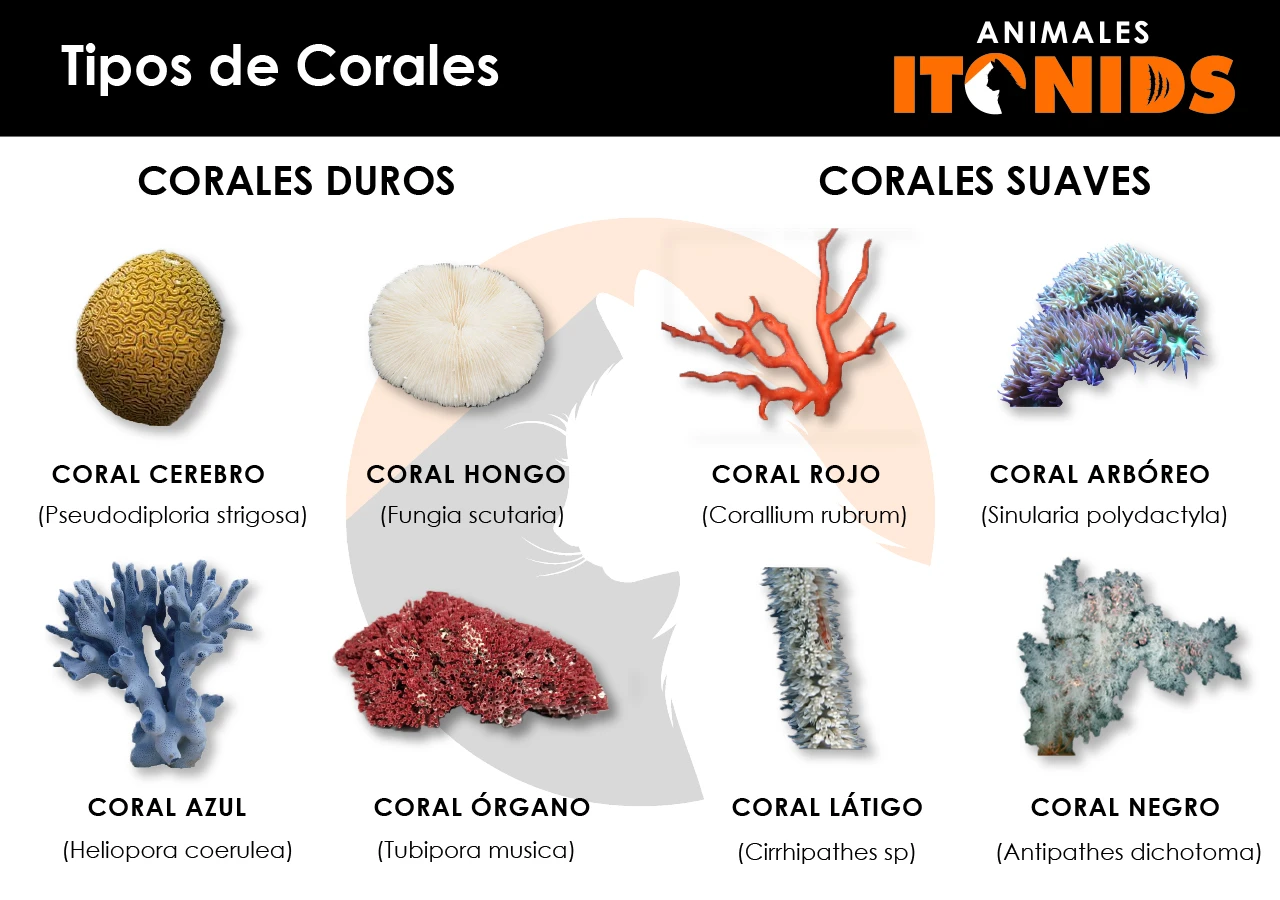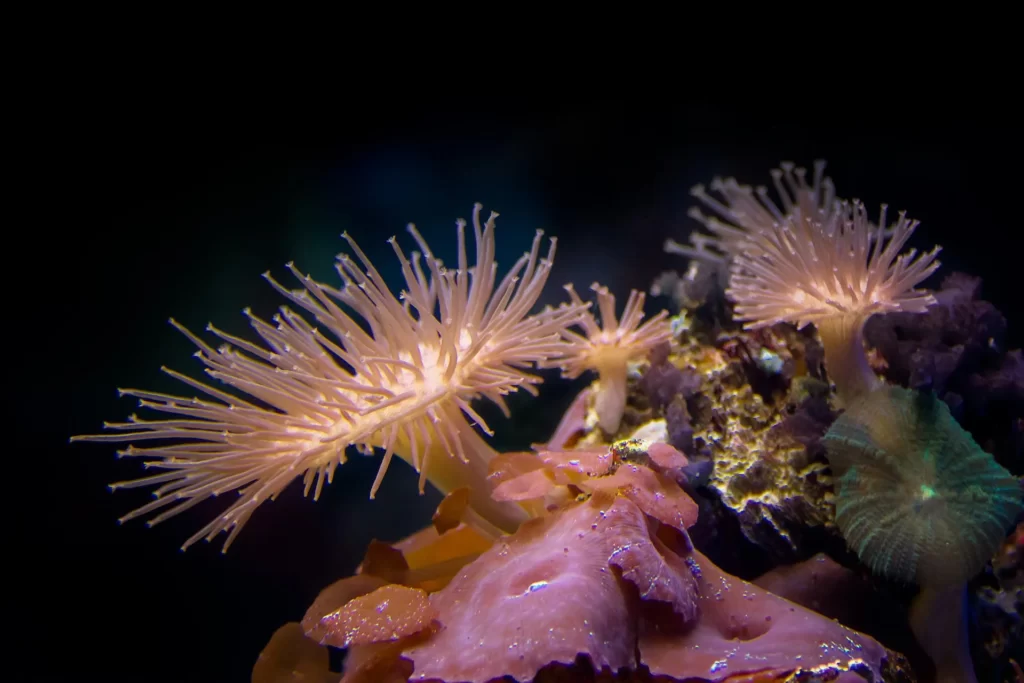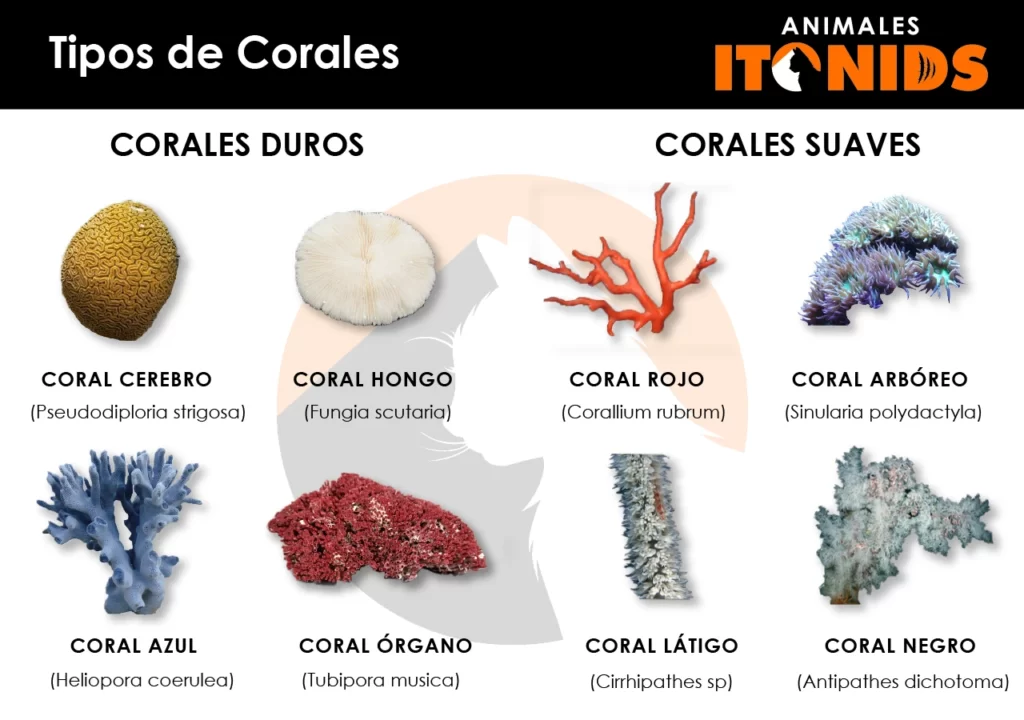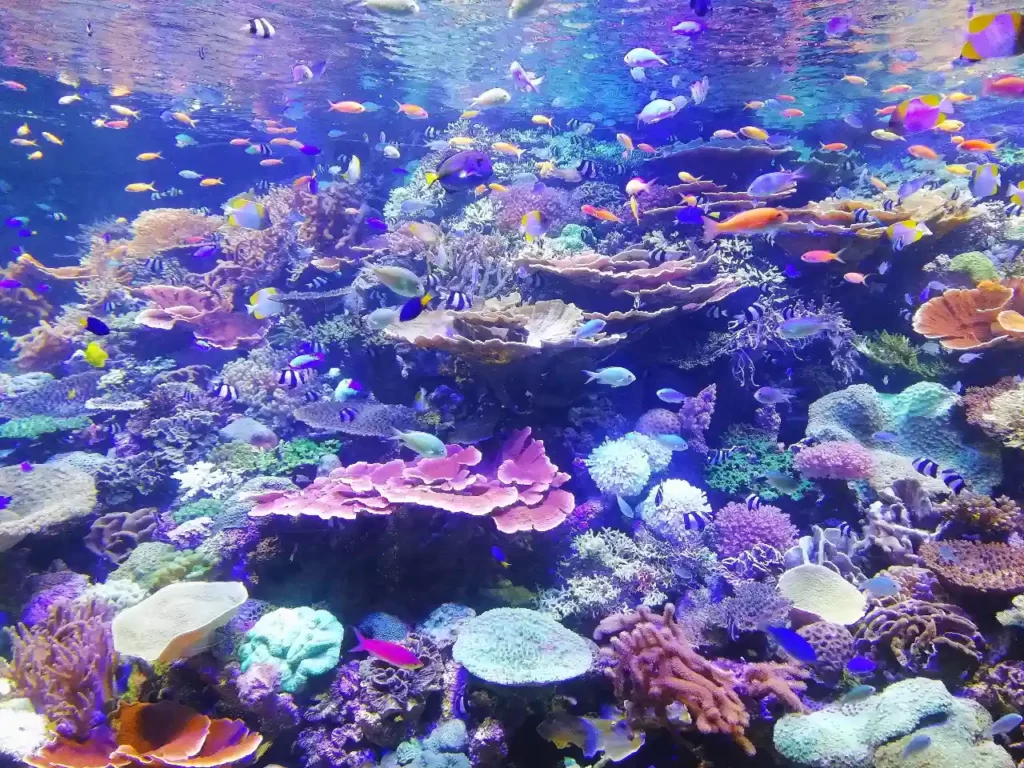“Corals” is a term referring to fascinating animals that have inhabited the Earth’s seas for millions of years, and are part of the “Cnidaria” group, which also includes jellyfish and anemones.
Together, corals form one of the most spectacular and valuable ecosystems on the planet called “coral reef”, known for their beauty, variety of shapes and colors, and as the home to many animal and plant species.
Moreover, they represent a significant tourist attraction and have great importance in medicine, the pharmaceutical industry, and cosmetics.
Want to know more? Dive in and discover what a coral is, its characteristics, the types of corals that exist, what it eats, where it lives, what a coral reef is…
Stick around because we’re telling you everything!
What is a coral?
A coral is a small and simple invertebrate animal (without a backbone), also known as “marine polyp”, coral polyp, or zooid, which possesses an external skeleton made of calcium carbonate that it produces itself.
The term “coral” also refers to the animal’s external skeleton, which joins together forming a unique armor to create a colony (coral reef) where thousands of polyps are attached.
The word coral derives from the Greek “Korallion” and the Latin “Corallium”, meaning “small stone”, due to its rocky appearance.
Did you know...? Ancient naturalists believed that corals were a marine plant that turned into stone when taken out of the water. Click To TweetCharacteristics of the coral
- Tiny animal (coral polyp) that has an external skeleton or exoskeleton.
- The exoskeleton is constructed from calcium carbonate (hard corals), with spicules, which are crystallized calcium in the form of spikes (soft corals), or with proteins (black corals), and is called “corallite” or the polyp’s house.
- In some species, there is a part of the skeleton that is located in the center and below the mouth (columella).
- The body generally has a tubular shape, though it can be round or elongated, and consists of two ends (oral and aboral).
- The oral end has an opening (which serves as both mouth and anus) and a crown of tentacles that sprout from a disc (oral disc).
- The tentacles are equipped with stinging cells (cnidocytes) and adhesive cells (spirocysts) at the tips, useful for capturing food.
- The other end, the aboral, is attached to the soft substrate by a peduncle (stem) or, in the case of hard substrates or bottoms, by a discopedium (disc).
- Its body is organized around a “gastrovascular cavity” or “coelenteron,” a kind of internal sack divided into several sections (septa).
- It has channels in the mouth (siphonoglyphs) that facilitate the entry of water currents into the gastric cavity.
- The body wall is formed by three layers: external (ectoderm), internal (endoderm), and a middle, gelatinous layer called mesoglea.
- On the outer layer appear epitheliomuscular cells, which are responsible for generating contractions in the muscles (longitudinal, transverse, retractors), and the reproductive structures (oocytes and spermatocytes).
- Around the mouth, the body wall folds inward forming a pharynx (actinopharynx).
- It has sensory cells near the mouth, on the tentacles, and the discopedium or peduncle (base) that allow it to receive chemical and tactile stimuli.
- It does not have an excretory, respiratory, or circulatory system. These functions, like digestion, are performed through the gastrovascular cavity.
- It has radial symmetry (its body is formed by several parts around an axis).
Types of corals
There are two types of marine corals: hard and soft
Hard corals
These are the corals that produce a hard skeleton, made of calcium carbonate, and live in small rocky groups at shallow depths (less than 60 meters) known as “coral reefs,” in a lighted environment and clear water.
In the reef, the coral associates with some species of algae (zooxanthellae), so they are also called “zooxanthellate or hermatypic corals,” building fixed, branched, and compact colonies extending several kilometers.
They can have tentacles in multiples of six (Hexacorallia) grouped in one or two rows, or have 8 tentacles (Octocorallia).
Specimens
Brain coral (Pseudodiploria strigosa), mushroom coral (Fungia scutaria), organ coral (Tubipora musica), blue coral (Heliopora coerulea)…
Did you know...? Blue coral (Heliopora coerulea) is attributed spiritual properties, and according to some people, calms emotions and brings inner peace. Click To TweetSoft corals
These are the corals that do not have a calcium carbonate skeleton and, therefore, do not create reefs (azooxanthellate), although they can inhabit one. Their body is supported by small calcium carbonate structures (sclerites).
They are also known as “leather or skin corals,” as most of them have a fleshy or solid appearance, giving the impression of being plants under the water.
As they do not associate with algae, they can live in deeper areas (up to 3000 meters).
They have 8 pinnate and hollow tentacles (Octocorallia), similar to pine branches; they live in groups or colonies in the form of a stem, mushroom, or bush.
Specimens
Arboreal leather coral (Sinularia polydactyla), Antipathes dichotoma, Cirrhipathes sp, red coral (Corallium rubrum)…
Did you know...? Black corals owe their dark and shiny coloration to a protein (antiphatin) and are popular in jewelry. Click To TweetTaxonomic classification of marine corals
Marine corals belong to the phylum “Cnidaria” (formerly coelenterates), class “Anthozoa” or flower-shaped animals (antho, flower, and zoo, animal); some are part of the Hydrozoa class (like Millepora sp).
Within Anthozoa, corals are subdivided into:
- Hexacorallia or Zoantharia, if they have tentacles in multiples of six.
- Octocorallia or Alcyonaria, if they have eight tentacles, and
- Antipatharia, which are the black corals, with six tentacles.
¿Qué es un arrecife de coral?
What is a coral reef?
A coral reef is a colony of living marine organisms made up of algae (zooxanthellae) and coral polyps (orders Scleractinia and Milleporina), which have a cooperative or symbiotic relationship with each other.
The algae provide energy and nutrients to the coral to form its external calcium carbonate skeleton, creating a marine relief filled with varied shapes and colors and hosting a great diversity of marine fauna and flora. In return, the coral provides protection and a structure to live in.
Coral reefs are the spawning ground (egg laying), breeding, and feeding place for more than 200 species of animals including crabs, corals, urchins, worms, lobsters, turtles, fish, among others.
Certain coastal and marine birds find rest and food in some reefs.
Did you know...? The Great Barrier Reef in Australia spans over 2000 kilometers, contains 400 types of corals, 1500 species of fish, and 350 types of mollusks, and you can see it from space! Click To TweetTypes of coral reefs
There are three types of coral reefs: fringing reefs, barrier reefs, and atolls.
Fringing reefs
Formed in shallow coasts and extend from land to sea (up to 50 kilometers); among them are the Great Barrier Reef off Australia, the reefs in the Red Sea, and those in the Indo-Malay region.
Barrier reefs
Originate far from the coast, on submarine ridges (below the water’s surface), separated from land by a deep lagoon; seen in Belize and the Indian Ocean.
Atolls
Associated with volcanic islands and are ring- or horseshoe-shaped reefs that surround a lagoon.
Found in the tropical Pacific and Indian oceans, famous ones include Tikehau Atoll in French Polynesia, Nukumanu in Papua New Guinea, and Pearl and Hermes in Hawaii.
Habitat of corals
Corals live in all oceans, in temperate, Arctic, and Antarctic waters, and the richest faunas are found in tropical seas, near the coast, at depths ranging from 50 to 200 meters.
They can be solitary or form colonies with other individuals (like zooxanthellae algae), leading to coral reefs, and their distribution varies according to depth conditions, temperature, water salinity, light, and type of substrate.
The development of coral reefs occurs in shallow waters, clear, with temperatures between 18 and 30°C, on a solid substrate for growth and exposed to sunlight.
Did you know...? Despite being marine habitats, in 2016, a coral reef was discovered near the mouth of the Amazon River - a great find! Click To TweetWhat type of nutrition does coral have?
Coral is carnivorous, feeding mainly on zooplankton, including copepods, tintinnids, veligers, cladocerans, fish eggs, and larvae. They can also consume phytoplankton, bacteria, and detritus (organic remains).
Most nutrients are obtained from the algae with which they share their habitat (zooxanthellae) thanks to the photosynthesis they perform; others (soft corals) filter suspended organic matter from the water or capture small organisms with their stinging and poisonous tentacles.
Reproduction of Corals
Depending on the species, corals can reproduce both sexually and asexually.
Sexual reproduction begins with the release of gametes or sexual cells into the water column by colony species or those living solitarily.

The reproductive models of corals vary: species can produce only oocytes (female gametes), spermatocytes (male gametes), or both types of gametes (hermaphrodites).
Once the gametes are released, external fertilization occurs, resulting in a small larva (planula) that attaches to the substrate and gives rise to the coral polyp. Fertilization can also occur inside the coral (acting as an incubator).
Reproduction occurs in brief periods, synchronized with the lunar phases. Generally, they can have one to two reproductive cycles per year.
Asexual reproduction occurs through division or budding, a process in which a new individual forms from a fragment or portion of the adult coral.
What color are corals?
Corals display a wide range of colors: red, yellow, gray, orange, pink, black, white, blue, brown… in unique combinations.
Despite the vibrant and varied colors they exhibit, the reality is that corals (polyps) are colorless; they are actually translucent animals.
The spectacular color tones they exhibit come from algae called “zooxanthellae” that live within the coral’s tissue.
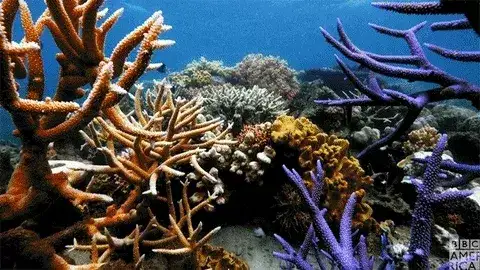
Names of Corals
- Antipathes dichotoma or black coral.
- Corallium rubrum or red coral.
- Pseudodiploria strigosa or brain coral.
- Fungia scutaria or mushroom coral.
- Tubipora musica or organ pipe coral.
- Heliopora coerulea or blue coral.
- Gorgonia flabellum or Venus sea fan.
- Stylaster roseus or pink coral.
- Sinularia polydactyla or arborescent leather coral.
- Acropora palmata or elk horn coral.
- Millepora alcicornis or fire coral (false coral).
- Lophelia pertusa or hard white coral.
- Dendrophyllia ramea or orange coral.
- Ellisella flagellum or whip gorgonian.
Importance of Corals
Coral reefs are ecosystems that harbor a great diversity of animal and plant species and are of great tourist attraction, in addition to acting as natural barriers or breakwaters, preventing coastal erosion.
Corals are a source of natural substances of great interest to the pharmaceutical and cosmetic industry; chemical compounds extracted from reefs are useful for research in curing arthritis, asthma, and AIDS.
They are also marketed for ornamental purposes, in aquariums, and their skeletons are used in the craft market and jewelry.
Particularly, corals living in deep marine areas are capable of recording changes in global climate.
Did you know? At the northern tip of Australia's Great Barrier Reef, a gigantic coral reef was discovered with a height of 500 meters, taller than the Empire State Building in New York (which reaches 381 meters). Click To TweetThreat
Coral formations are constantly threatened by human activity: uncontrolled fishing practices, the search for hydrocarbons (gas, oil), the use of fertilizers, and nautical activities (navigation, diving, swimming) are some of them.
Global warming and pollution have also seriously affected these ecosystems worldwide; the increase in water temperature causes corals to expel the algae from their tissues, leaving them without food and causing their death.
References
BBC News Mundo. (2020). A coral reef taller than the Empire State Building discovered in Australia. https://bbc.in/39lm05N
Greenwood, V. (2017). The dangerous appetite of corals for plastic. The New York Times. https://nyti.ms/3wtjz9g

